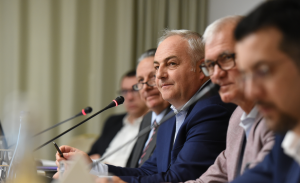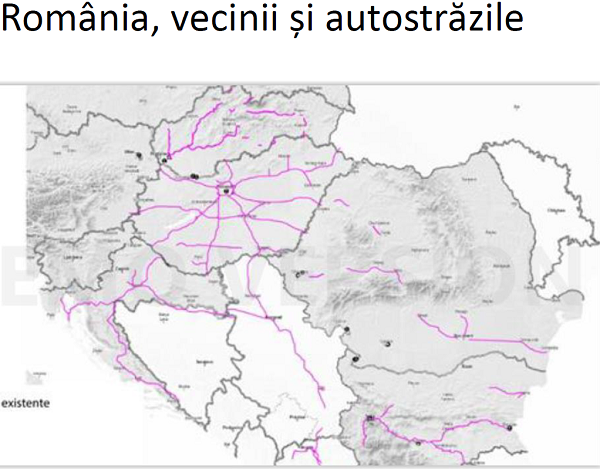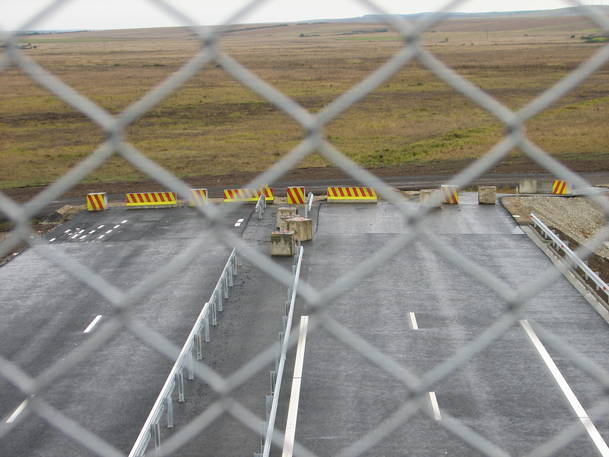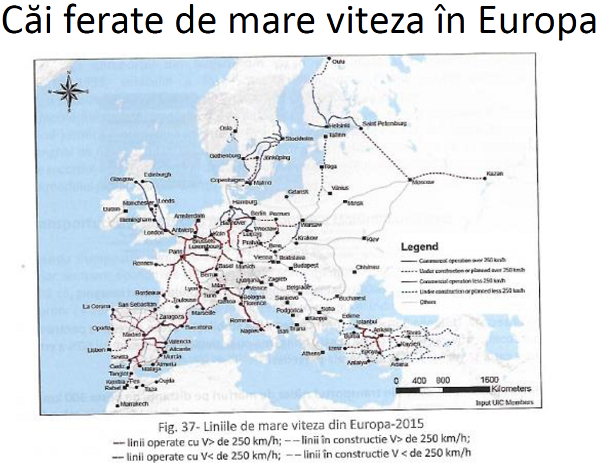In the medium and long term, companies in Romania lose business because of disarticulated infrastructure; the country overall loses new investment, the state budget loses twice – the extra taxes from companies that could develop their business and taxes from investment nipped in the bud.
By the way the highways map shows today in our region and in Europe, we are pulling ourselves out of the European-Asian equation, still deferring key investments.
 Starting from these simple premises, Romanian Business Leaders held a conference on Thursday to present the „radiography” of the national transport networks and proposed to the authorities measures for developing the road and railway infrastructure and for the fluidization of traffic.
Starting from these simple premises, Romanian Business Leaders held a conference on Thursday to present the „radiography” of the national transport networks and proposed to the authorities measures for developing the road and railway infrastructure and for the fluidization of traffic.
Conference speakers were: Felix Patrascanu, Managing Partner FAN Courier, RBL board member, Florin Furdui, Country Manager Portland Trust, RBL board member, Ion Lixandru, General Manager Romtrailer, Mihai Rohan, President of CIROM (employers association in the cement industry), Decebal Popescu, CEO of CARTRANS Romania.

Regarding the road infrastructure, RBL recommends:
To the Ministry of Transport
- to seek advice and technical assistance from the European Investment Bank for defining a coherent strategy on major transport infrastructure projects and applying sound working principles to achieve a consistent absorption of European funds and implement successful projects.
- to quickly make the program of project implementation transparent to provide a vision and direction to companies from the market, to properly manage activity and resources until the start of the works.
To the National Road Traffic Management Company:
- to ensure that project implementation is operative, we propose that CNAIR should turn to external consultants to take over the management of programs (as the US state of Oklahoma did in the crisis year 2008 with a budget of USD 1 billion for 3 years).
- to include in the evaluation of tenders an additional score to assess the similar experience that participants have at the local level. To develop a system of appropriate rating factors, it is necessary for CNAIR to request models from international funding institutions such as the EIB, EBRD and the World Bank, publicly discuss with industry specialists the proposals for evaluation factors and analyse models applied in other EU member states.
- to responsibly deal with the preparation phase. Professional and responsible design services optimize the construction process, which is the most costly of the entire project cycle. Design services account for only 2-3% of the total cost of an investment.
- to launch tenders for the feasibility studies along with the technical design (as is currently the case for corridor IX) to save time for designing by eliminating certain tender phases. The result will be a well-drafted project that will be the basis for the selection of the construction company, whose main concern will be to adapt its technology according to the solutions identified in the project. In practice, today, the feasibility study is misused as a basis of tenders for design and implementation and is treated as a technical project where the construction company is not allowed to intervene.
Regarding the fluidization of the road traffic, RBL recommends:
- increasing the speed limit to 70 km/h in localities where each direction has two lanes, and there are separators between the directions (for example, localities between Bucharest and Giurgiu)
- the implementation of an electronic road traffic monitoring and control system, based on the interoperability of the Romanian Car Register (RAR) databases, DRPCIV, the Financial Supervisory Authority for compulsory automobile liability insurance (CEDAM), the National Company for Road Infrastructure Administration (CNAIR) for the vignette, the Ministry of Public Finance for taxes and fines in the traffic regime, the Romanian Road Authority (ARR) for the licensing of freight or passenger transport vehicles and the State Inspectorate for Road Traffic Control (ISCTR).
- An electronic platform would ensure the permanent (live) control of all vehicles in the traffic for the validity of ITP, RCA, and vignette; bridge toll; non-payment of local tax/property, non-payment of fines; the entry into service of vehicles with false registration numbers, without registration number or stolen vehicles; the possession of the transport license (in the case of freight/passenger vehicles subject to licensing) and complying with the maximum permissible axle weight.
- The electronic platform would ensure the permanent control of the traffic status through traffic values calculated on time slots, legal holidays, summer periods; average speeds and type of vehicles in traffic: cars, passenger cars, commercial vehicles, special vehicles, etc.
As far as the railway infrastructure is concerned, RBL asks the Romanian authorities to respect the commitments made to European partners and proposes and supports the following measures:
- Reception in 2018 of at least 140 km of the European freight and passenger network (TEN-T). Without these kilometres of railway, the average speed of trains in Romania will decrease even further, as between Simeria and km 614 (four railway sections) works will start that will lead to the decrease in speed on this section to 30 km/h.
- Emergency electrification of 58 km of railway between Giurgiu (from the border with Bulgaria) and Radulesti (Videle) as an alternative route to the Bucharest-Giurgiu section (the first railway section from Wallachia territory), which has been closed over 12 years ago. The urgency of the proposal is emphasized by the fact that Bulgaria and Greece have complained to the European Commission that they cannot connect to TEN-T because Giurgiu-Bucharest railway route is not operational, and they have to change the locomotive because there is no continuity from Ruse, respectively Giurgiu.
- Urgent drafting of a feasibility study for high-speed railways in Romania. Although protocols have been concluded for the high-speed railway between Vienna, Budapest-Bucharest-Constanta, progress is delayed due to the Romanian part. Hungary has already announced that it has secured the necessary funds for the feasibility study for a high-speed railway between Budapest and Cluj-Napoca.
- Despite the surface and length of the pre-existing rail network, Romania lost its dominant position in the region to Austria and Hungary, due to the great delays in the implementation in Simeria and Coslariu areas. Romania’s neighbours are increasingly interested in connecting with our country, and the latest announcement came from Serbia, which sees that a high-speed railway between Bucharest and Belgrade is needed.
- Building a road and rail corridor to connect the three European seas: the Baltic Sea to the Adriatic Sea and the Aegean Sea.











